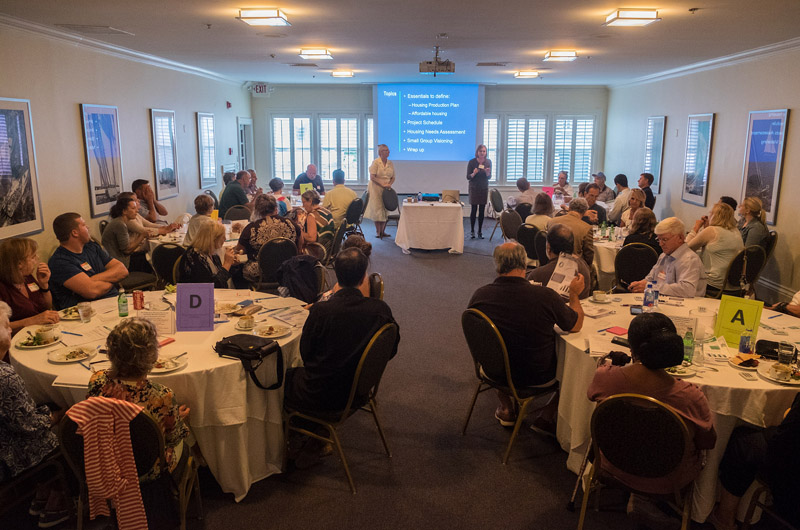Residents from Edgartown to Aquinnah this week weighed in on a major effort to increase the Island’s stock of affordable housing. A series of public workshops in schools, community centers and other public places presented data related to housing needs and demographics in each town and gathered public feedback.
JM Goldson, a community planning firm in Boston which is overseeing the process, expects to develop official housing production plans (HPPs) for each town, along with an Islandwide plan, by February.

The plans would provide a roadmap for how to achieve the goals of Chapter 40B of the Massachusetts General Laws, which indicates that at least 10 per cent of the housing stock in each town should be affordable. Meeting that goal is one stated objective of the initiative.
Affordable housing is generally defined as costing less than 30 per cent of a household income, although housing projects often target specific income groups, such as people earning less than 80 per cent of the area median income. The median income for a family in Dukes County is about $86,000, according to the U.S. Census, although the income limits for affordable housing vary by household size.
Judi Barrett, director of municipal services for RKG Associates, an economic planning firm working with JM Goldson, said about one third of the communities in the state already have housing production plans, although some have expired or have yet to be approved. Many have served a strategic purpose, she said, as towns prepare for large projects they hope will count toward the housing production goal.
The efforts on the Vineyard originated early this year when the all-Island planning board adopted a charter to vastly increase the Island’s affordable housing stock by way of the housing production plans. The Martha’s Vineyard Commission, nonprofit Island
Housing Trust and Martha’s Vineyard Donor’s Collaborative are also partners in the initiative.
Data presented at the workshops drew from many sources, including the U.S. Census and American Community Survey, along with the Donahue Institute at the University of Massachusetts, and the federal Department of Housing and Urban Development. But the planners have acknowledged the challenge of deriving accurate data from such small communities.
“We can only learn so much from the data, sitting at our desks by ourselves,” Jennifer Goldson, owner of JM Goldson, said at the opening workshop in West Tisbury on Monday. “One of the main reasons we are here tonight is to hear from you.”
Ms. Barrett, who joined Ms. Goldson and provided more detailed assessments of housing conditions in each town, agreed that the data for small communities are sometimes less than ideal, but didn’t see it as a big obstacle. “My experience working with these data sets is that when you view them in their entirety and you look at trends over time, there is a story to be told that is pretty consistent,” she said.
Planners are still working to obtain data related to local building permits. To fill in some of the gaps, they have purchased a large amount of data from the Warren Group, which handles real estate and financial information for Dukes County.
Information presented at the workshops painted a relatively detailed picture of living conditions in each town and how they may change over the next 20 years. Based on the available data, for example, the Island year-round population is expected to grow 12 per cent by 2035, although most of the growth would be down-Island (Aquinnah and Chilmark show an opposite trend).
People 65 and over are projected to account for 29 per cent of the Island’s year round population by 2035, compared to 21 per cent in 2014. Aquinnah and Chilmark would see the largest increase.
The number of households in almost every town is shrinking, according to the data, while household size is growing. That may relate to an observed increase in school enrollment, although the prepared data did not address that issue directly. The average household size on the Island grew from 2.3 to 2.86 between 2000 and 2014, while the number of households shrank from 6,421 to 5,839, according to the U.S. Census. Only in Oak Bluffs have both measures increased.
Chilmark has the highest overall income levels compared to the county, and Tisbury has the lowest. On average, household incomes for people under 25 in Tisbury are about $46,053, compared to the state average of $73,310. The same age group in Chilmark earns about $102,700. Islandwide, the figure is $50,114.
All towns show a declining proportion of people ages of 20 to 64, according to various data sources, with 2035 projections ranging from 44 per cent in Aquinnah to 55 per cent in Tisbury. Edgartown’s overall population growth would be almost flat, at two per cent, with the 20-64 age group projected to shrink from 66 to 53 per cent in 20 years.
Workshop participants were given small devices that enabled instant survey responses, with the results projected onto a screen. In five towns (Tisbury’s workshop took place after press time), most respondents said they have lived on the Vineyard for more than 20 years, although Oak Bluffs included more new arrivals. In each town, most participants said they own a year-round home, although Aquinnah, Chilmark and Edgartown included more longer-term homeowners, who moved in before 2000.
When asked their reason for attending the workshop, a vast majority chose “advocate for affordable housing,” although many chose “gather information.”
Data also touched on the issue of housing cost, with most towns showing a heavy burden among renters, especially those with a moderate, low or extremely low incomes. Nearly 60 per cent of the available rental units in West Tisbury, for example, exceeded $1,500 per month, including utilities. Islandwide, an estimated 52 per cent of low- and moderate-income households are severely cost burdened, according to the data.
Planners highlighted the influence of seasonal homeownership, which they say squeezes lower-income renters out of the housing market. In West Tisbury, for example, Ms. Barrett described a housing market “consumed by the interest and demand and willingness to spend of predominantly seasonal buyers. You don’t see those kind of costs on the mainland, and you don’t see those kind of costs in non-seasonal areas. You see them on Nantucket and you see them in South Berkshire county.”
The U.S. Census indicates that about 65 per cent of all houses on the Island are vacant in the winter, a trend that Ms. Barrett said affects the whole Island. “Everybody is trying to find a place to live,” she said in Oak Bluffs. “And when there is not enough supply and not enough choice within the inventory . . . that’s when the pricing really goes haywire.”
Another common feature of resort communities, she said, is the abundance of multiple homes on a single lot. The ratio is especially high in West Tisbury, with about 4.6 single family homes for every one property, and in Chilmark. “That type of property tends to have very high value,” Ms. Barrett said, noting that it also drives prices up.
Workshop participants spent about an hour in small groups envisioning ideal housing situations in their town and identifying obstacles to achieving those goals. Planners will include the results of the exercise in a later report, along with an update to the Island’s 2013 housing needs assessment and the final housing production plans.
Ms. Barrett said the exercises this week were at least partly aimed at further refining the data. “It’s a tall order to try to get to 10 per cent in towns this small,” she added. “So you kind of have to give people permission to talk about what they think they can do.”
Additional workshops are planned for the fall.
For more information on the housing production plans, visit mvcommission.org/housing-production-plan.










Comments (13)
Comments
Comment policy »